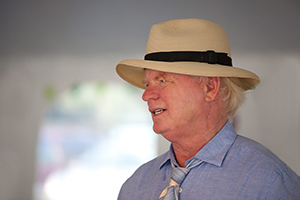
John Todd
John is widely published and is the author of over two hundred scientific, technical and popular articles. He is the author or co-author of seven books. He is the holder of a number of patents and the inventor of Eco-Machines™, systems in which life does the “heavy lifting” of water purification.
John’s passion and work revolve around the broad field of planetary healing. John was educated at McGill University (BA in Agriculture and MSc in Parasitology) and holds a PhD from University of Michigan (Fisheries & Oceanography). He has also received two honorary doctorates. He has received over a dozen awards including the first Buckminster Fuller Challenge, “Design for a Carbon Neutral World: The Challenge of Appalachia” for the best idea to help save humanity. He was named a “Hero of the Planet” by Time Magazine in 2000. He has been a hero to many of us here at Biohabitats, and we were thrilled to chat with him about the use of Eco-Machines for on-site wastewater treatment and reuse.
Much of your early work in the 1970s centered around the use of ecological design for food production. Can you share a bit of that background with us, and then tell us what led you to focus on wastewater treatment?
My background is quite eclectic. I studied and earned degrees in agriculture (undergraduate) tropical medicine and parasitology (graduate), and lakes, oceans, and the behavior of animals in aquatic environments (doctorate). In 1970, I, along with my wife [Nancy Jack Todd] and my friend, William McLarney, established the New Alchemy Institute. Its goal was to integrate disciplines that are normally separate, such as architecture, energy, and food production. One of our first tasks was to create miniature worlds, or microcosms, for growing food. The first system we created was a geodesic structure that housed a pond within which we cultured a number of different species of fish. The pond itself supported the trees and agriculture within the structure. From the very beginning, we were looking for non-polluting, non-chemically dependent, non-toxic-material-using ways of intensively growing food. The ideas at New Alchemy took off. Tens of thousands of visitors came throughout the 70s and 80s, including Nobel Laureates and famous people like Margaret Mead and Gregory Bateson. It was like a who’s who of that era. It was quite a remarkable institution that had a global impact.
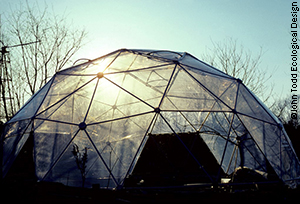
Geodesic structure at the New Alchemy Institute
At the same time, I was also working as an oceanographer at the Woods Hole Oceanographic Institution. At that time, there was talk of using atomic energy to dig a sea-level canal in Central America from the Pacific to the Atlantic. I was hired by the Atomic Energy Commission to find out if fishes that live in the Atlantic interbreed and hybridize with fishes from the same family that live in the Pacific.
The first thing I did was to try to simulate tropical, intertidal environments in greenhouses; in this case I used geodesic structures. So I had to learn how to assemble ecosystems. Inspired by noted ecologist Howard T. Odum’s theories about designing complex systems and having them self-organize, self-design, and self-repair, I said, “I’m going to try this!”
We were in the north and the ecosystems had to be tropical as well as recycling, so that they could heat themselves up and stay warm. I had to have tidal ecosytems that were so genuine that the marine fishes would breed in captivity. Very few marine fishes had ever been bred at that time. I flew to Costa Rica and collected live specimens of Bathygobius from both the Atlantic and Pacific Oceans. I discovered that a goby from the Atlantic would interbreed with a goby from the Pacific, but not with another species of goby from the Atlantic. I don’t think my report, which indicated that there would be problems with a sea level canal, influenced the course of history one bit. The interesting part was the designing of ecosystems with a specific function.
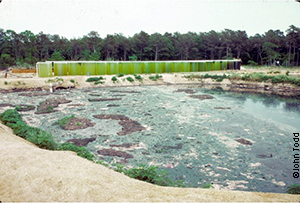
The pond in Cape Cod
By the middle of the 1980s, we were losing some of our friends to cancer in my hometown, and I was convinced that they were environmentally induced cancers. So I began to look around. The first place I looked was a pond in a Cape Cod town where they dumped waste from pump out trucks. I discovered that all of the EPA’s top 15 chemicals of concern were in that pond; the water was a toxic soup. Since the pond was unlined, this toxic soup percolated four or five feet down into the water table of the town. I began to investigate and realized [the pumped out waste] wasn’t just from household septic tanks; it was from small businesses, veterinary clinics, medical clinics, old peoples’ homes…the list was endless. Contaminated waters then became my primary focus, and I committed myself to trying to invent living technologies to clean up this stuff.
When it came to working with the design of living systems to treat toxic waste, I knew from my experience at New Alchemy that we had to work with sunshine, and that conventional wastewater treatment was almost totally dependent on bacteria. To optimize sunlight in those early systems, the tanks were made of light transmitting material: thin fiberglass. Into these photosynthetic vats, we began to seed tens of thousands of species of organisms from dozens of wild environments in the area.
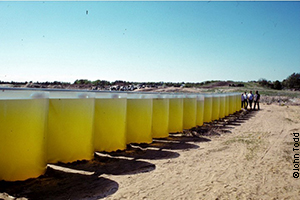
Fiberglass vats
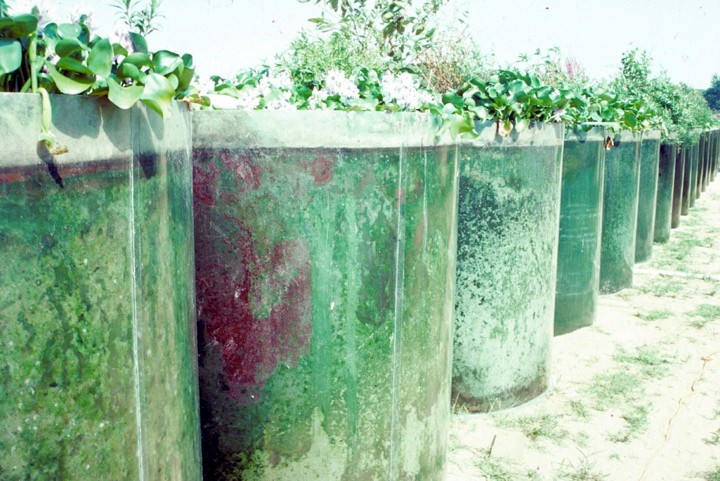
Life does the work in the Eco-Machine
We understood that if we were going to create a new technology, we needed to borrow strategies from different kinds of parent ecosystems; a marsh, a pond, and moving components like streams or rivers. This understanding, along with the science of assembly, led us to the design of these systems. In the end, our technologies ended up being mechanically quite simple. We used aeration throughout parts of our design, and discrete cells that were connected to form a stream or river, like beads on a string. This system was able to convert the terribly polluted water to clean water in just a little over ten days. It was quite amazing.
We understood that if we were going to create a new technology, we needed to borrow strategies from different kinds of parent ecosystems; a marsh, a pond, and moving components like streams or rivers. This understanding, along with the science of assembly, led us to the design of these systems. In the end, our technologies ended up being mechanically quite simple. We used aeration throughout parts of our design, and discrete cells that were connected to form a stream or river, like beads on a string. This system was able to convert the terribly polluted water to clean water in just a little over ten days. It was quite amazing.
One of the great biologists of the 20th century, Lynn Margulis, was a big influence on me. Her students looked at life inside this system—this toxic reservoir—and they could identify all of the organisms they found. However, they saw communities they had never seen before on Earth. In other words, Nature was inventing new communities in response to the type and strength of the waste in each stage of the treatment process. That was quite a revelation, and I was humbled. At that stage, I knew that I could never understand the pathways, complexities, and mechanisms that were going on in these tanks. Only in recent years have we begun to get inside some of these ‘ecological black boxes’ with genetic inventorying and very recent microbial work. 2016 is a very interesting time. It is a good era to be an aquatic scientist and to be interested in remediating polluted waters.
In lay terms, what is an Eco-Machine™, and how does it clean polluted water?
The framework is what I’d call conventional civil engineering. Eco-Machines™ differ, however, from conventional systems because they use life as substitutes for something inert and added. What separates an Eco-Machine™ from a conventional system is not so much the engineering as the conscious utilization of all of the kingdoms of life in the process.
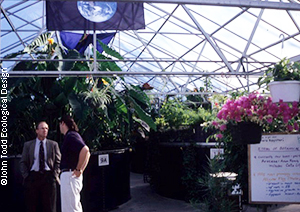
Inside the South Burlington Eco-Machine
For example, an eco-machine will use the roots of higher plants, which are often rafted on the surface, as an active source of the transfer of photosynthetic energy in the form of carbon products into supporting the beneficial communities around the root systems. A conventional system might use a [synthetic] media which is sticky enough that bacteria like it.
Eco-machines have a diversity of functions. Their commonality is that the designer or engineer creates the processes within the machine based on the task it must complete. Eco-Machines™ have been used to grow food, treat sewage, clean up toxic waste, remediate damaged environments, and even to generate fuel.
For example, if you want your Eco-Machine™ to treat sewage, you have to make sure there is enough retention time in the system to allow for the complete conversion of ammonia to nitrogen gas. As in most wastewater treatment systems, that’s going to involve oxygen-driven processes and oxygen-starved environments in order to complete the process. You also need to make sure you have enough surface area for microorganisms so that they can utilize the BOD [biochemical oxygen demand] as a food source. You also want to have the proper sites for organisms that will take the water and clarify it. To remove the pathogens biologically, there has to be enough retention time and enough exposure to an oxygen-rich environment for the organisms that handle that task.
Eco-machines are beneficial because they decrease the amount of energy and external chemicals normally used in a conventional system, and most of the heavy lifting is done by life itself.
Can eco-machines also be economic engines?
We have not consciously focused on the economic byproducts of living machines, but we should. For example, the South Burlington Municipal Eco-Machine™ [which was designed to remove nutrients and pollutants from wastewater] also produced papyrus. The Earth Charter at the United Nations was written on papyrus that was grown there.
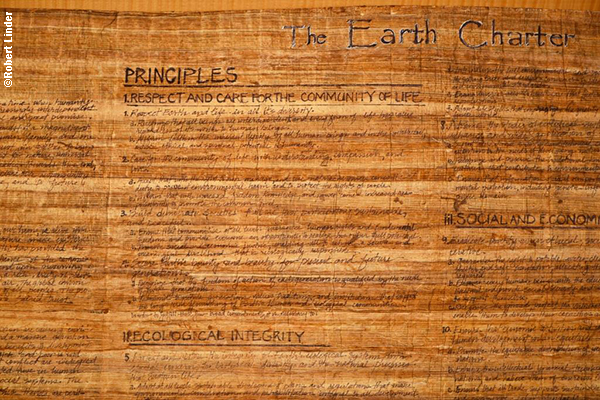
The Earth Charter
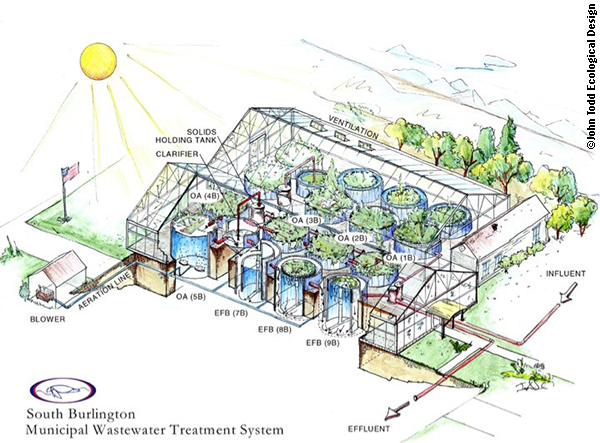
Another example is an experiment we did in Frederick, Maryland, where we used Japanese koi fish as a major strategy for sludge reduction. The sludge was enough of a diet for the koi to grow and thrive. We purchased the koi for $0.99 each at the beginning of the experiment. A year later we sold them for $10 apiece to people in the ornamental pond business, who then probably sold them for much more. Despite these examples, we never sat down and took the time to ask why a community can’t have a wastewater treatment plant that not only gives them clean water, but also pays for itself through the production of highly valuable products.
Do you suspect there are places in the world or segments of society that would not only accept the Eco-Machine™ but where there would be opportunity for economic tie in?
A good place to start might be to use the early stages of riparian plants, as seedlings and young shrubs, in the treatment process. I could see a community using their Eco-Machine™ to produce the genetic material [which contractors might otherwise have to purchase from specialty nurseries] for streambank restoration and riparian recovery projects. Another revenue source that we have developed is cut flowers that thrive in the treatment process. Calla lilies are a good example.
What has been one of your most valuable failures–in terms of lessons learned–in the use of Eco-Machines to treat wastewater?
Where we as a community of practitioners learn the most from our mistakes is during the process of commissioning Eco-Machines. Usually, the systems are seeded by a diversity of life. Very often that includes a slug of microorganisms from another sewage treatment plant. The commissioning of a system, also known as the ramping up process, is complex ecological business. Unfortunately, we usually do not budget or allow the resources for someone who really understands that when you seed a system, it’s not a single seeding. It’s a multi-level system that builds as the system learns. The rate at which it accepts waste also has to incrementally increase; it cannot start as a full-blown system. This ramping up process is between a one- and two-month time period, yet we rarely have our applied ecologists on the ground during this period.
I think one of the reasons why the Eco-Machine™ in Corkscrew Swamp Sanctuary in Florida is working better than it was 25 years ago is because the system is learning from the surrounding swamp itself. Life from outside is getting in, so the system is constantly self-designing and self-organizing. The system is open to the environment, so such an exchange is possible in that case.
What advice can you share for architects, designers, or engineers who want to encourage a risk-averse client to consider an Eco-Machine™ for on-site wastewater treatment?
Although the economic argument can be made very effectively in many cases, I wouldn’t start with that. I take a different approach. I say to people, “You will be very happy with something that is beautiful, doesn’t stink, and is a positive asset.” I would then ask them to visit a system like the one at the Omega Center for Sustainable Living, and afterwards visit a conventional sewage treatment plant. In the documentary Green Machine, which is primarily about the Eco-Machine™ at Corkscrew Swamp, the plant operator takes the filmmaker to a conventional sewage treatment plant and says, “Nobody wants to be here.”
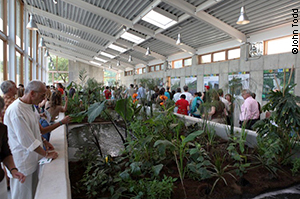
Omega Center for Sustainable Living
Another driver is that more and more people want to build systems that are carbon positive, and will meet the needs of the Living Building Challenge.
Have you seen any situations where Eco-Machines™ do not make sense?
Yes. If a community has the climate and the land, why not go with a beautiful constructed wetland, which is a guaranteed carbon positive system that uses very little energy? That is a no brainer. This constructed wetland can be turned into botanical gardens, so people can come to appreciate this living thing that is doing so much for them.
You have inspired a generation of ecological engineers. You have mentioned H.T. Odum and Lynn Margulis. Who else inspired you early in your education or career?
H.T. Odum’s book Environment, Power and Society was a big influence on me. At McGill and at the University of Michigan I had two or three very good professors who were influential. I think I was most influenced by the whole systems thinking that took place in the 60s and 70s, by people like James Lovelock and Gregory Bateson. There is a recent book out about this called Groovy Science. I have always been fascinated by evolution because I think it holds the keys to a lot of future design, so evolutionary scientists have also been important to me. I like to know what happened over the last three billion years. Nature is inventing, testing, trying, rejecting, and mutating all the time. There have got to be some narratives there that we must tap into as Earth stewards.
All of us involved in regenerative design, ecological restoration, and conservation planning see themselves as Earth stewards. The work of trying to rescue the planet from its degraded state is the great work of our time. Fortunately, there is a lot of talent out there.
Looking back to the time when you founded New Alchemy, how far would you say we’ve come in integrating seemingly separate disciplines?
One way to measure it would be to go onto college and university campuses. When I started out, it was impossible for architects, ecologists, engineers, physicists, and horticulturalists to work together. They were in separate silos. There is still a tendency, among scientists, to stay in their silos because early in their careers they struggle for tenure, and tenure is measured by the amount of papers you write around a fairly narrow range of subjects. Today however, there are a number of campuses around the country that have complex collaborations. There are reasons for hope!
You have said that if we can “tease out the hidden language of nature” and look to nature for our instructions, “we could reduce the negative human impact on this planet by as much as 90%.” Generally speaking, how well do you think we are doing in seeking and learning that language?
I just reviewed a book called Grass, Soil, Hope by Courtney White for our publication Annals of Earth. When I finished that book and realized the number of people worldwide who are noticing the transformative potential of this planet, and who are using carbon as a measure of success, I felt very positive. This book does a very good job of explaining what the tools are, who is developing them, and where they are located. White even talks about a group in southern France that figured out how to improve crop yields by having solar panels placed in their fields at a certain height and angle. There is so much strange, wonderful stuff going on!
Speaking of strange, wonderful stuff…earlier, you mentioned that we are gaining the knowledge to unlock more “ecological black boxes.” What ecological black box are you most eager to open?
There is something I’m interested in for global climate reasons. How do we take a body of water that is polluting the atmosphere with excess CO2 and convert it to a body that is sequestering atmospheric CO2? Then how do we transform that CO2 into stable carbon that will remain in the system’s sediment itself for a long period of time?
When we’re trying to heal a pond or something similar, we’re trying to limit one of the primary elements. In our case it’s mostly nitrogen. But I think in doing that, we have not allowed the mechanisms in that body of water to carry out the optimal carbon cycle which will create the opportunity for self-healing in that system. I’m kind of obsessed by that these days. Fortunately, I’m about to start working with some scientists in Florida who are interested in carbon and water. We may start doing experiments at Corkscrews. In soils, there is this sticky protein called glomalin and it is produced by a symbiotic relationship between the roots of plants and funghi. I would like to find the aquatic analog. What are the sticky proteins, if you will, in a body of water, and how do we support their growth?
How can our readers stay up to date on the progress of that research?
Our publication, Annals of Earth contains an article I wrote called “Remediating Polluted Waters.” Every three years or so, I try to update this for the publication.

